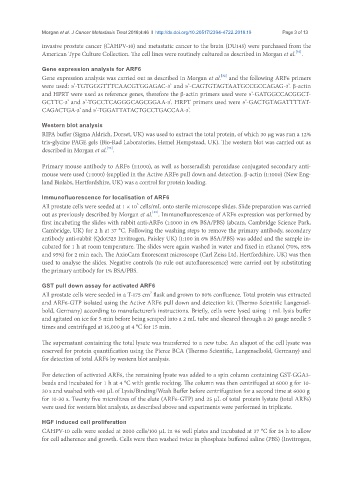Page 547 - Read Online
P. 547
Morgan et al. J Cancer Metastasis Treat 2018;4:46 I http://dx.doi.org/10.20517/2394-4722.2018.19 Page 3 of 13
invasive prostate cancer (CAHPV-10) and metastatic cancer to the brain (DU145) were purchased from the
[32]
American Type Culture Collection. The cell lines were routinely cultured as described in Morgan et al. .
Gene expression analysis for ARF6
[32]
Gene expression analysis was carried out as described in Morgan et al. and the following ARF6 primers
were used: 5’-TGTGGGTTTCAACGTGGAGAC-3’ and 5’-CAGTGTAGTAATGCCGCCAGAG-3’. β-actin
and HPRT were used as reference genes, therefore the β-actin primers used were 5’-GATGGCCACGGCT-
GCTTC-3’ and 5’-TGCCTCAGGGCAGCGGAA-3’. HRPT primers used were 5’-GACTGTAGATTTTAT-
CAGACTGA-3’ and 5’-TGGATTATACTGCCTGACCAA-3’.
Western blot analysis
RIPA buffer (Sigma Aldrich, Dorset, UK) was used to extract the total protein, of which 30 μg was run a 12%
tris-glycine PAGE gels (Bio-Rad Laboratories, Hemel Hempstead, UK). The western blot was carried out as
[32]
described in Morgan et al. .
Primary mouse antibody to ARF6 (1:1000), as well as horseradish peroxidase conjugated secondary anti-
mouse were used (1:1000) (supplied in the Active ARF6 pull down and detection. β-actin (1:1000) (New Eng-
land Biolabs, Hertfordshire, UK) was a control for protein loading.
Immunofluorescence for localisation of ARF6
5
All prostate cells were seeded at 1 × 10 cells/mL onto sterile microscope slides. Slide preparation was carried
[32]
out as previously described by Morgan et al. . Immunofluorescence of ARF6 expression was performed by
first incubating the slides with rabbit anti-ARF6 (1:1000 in 6% BSA/PBS) (abcam, Cambridge Science Park,
Cambridge, UK) for 2 h at 37 °C. Following the washing steps to remove the primary antibody, secondary
antibody anti-rabbit (Qdot525 Invitrogen, Paisley UK) (1:100 in 6% BSA/PBS) was added and the sample in-
cubated for 1 h at room temperature. The slides were again washed in water and fixed in ethanol (70%, 85%
and 95%) for 2 min each. The AxioCam fluorescent microscope (Carl Zeiss Ltd, Hertfordshire, UK) was then
used to analyse the slides. Negative controls (to rule out autofluorescence) were carried out by substituting
the primary antibody for 1% BSA/PBS.
GST pull down assay for activated ARF6
3
All prostate cells were seeded in a T-175 cm flask and grown to 80% confluence. Total protein was extracted
and ARF6-GTP isolated using the Active ARF6 pull down and detection kit (Thermo Scientific Langensel-
bold, Germany) according to manufacturer’s instructions. Briefly, cells were lysed using 1 mL lysis buffer
and agitated on ice for 5 min before being scraped into a 2 mL tube and sheared through a 20 gauge needle 5
times and centrifuged at 16,000 g at 4 °C for 15 min.
The supernatant containing the total lysate was transferred to a new tube. An aliquot of the cell lysate was
reserved for protein quantification using the Pierce BCA (Thermo Scientific, Langenselbold, Germany) and
for detection of total ARF6 by western blot analysis.
For detection of activated ARF6, the remaining lysate was added to a spin column containing GST-GGA3-
beads and incubated for 1 h at 4 °C with gentle rocking. The column was then centrifuged at 6000 g for 10-
30 s and washed with 400 µL of Lysis/Binding/Wash Buffer before centrifugation for a second time at 6000 g
for 10-30 s. Twenty five microlitres of the elute (ARF6-GTP) and 25 µL of total protein lystate (total ARF6)
were used for western blot analysis, as described above and experiments were performed in triplicate.
HGF induced cell proliferation
CAHPV-10 cells were seeded at 2000 cells/100 µL in 96 well plates and incubated at 37 °C for 24 h to allow
for cell adherence and growth. Cells were then washed twice in phosphate buffered saline (PBS) (Invitrogen,

